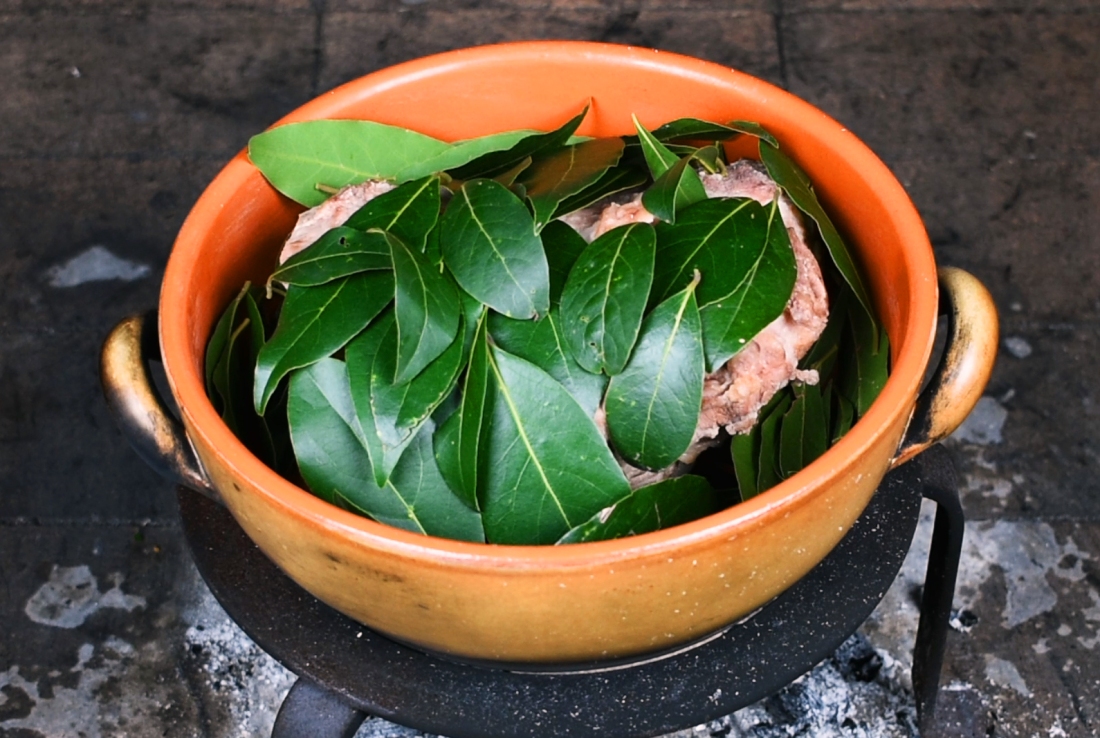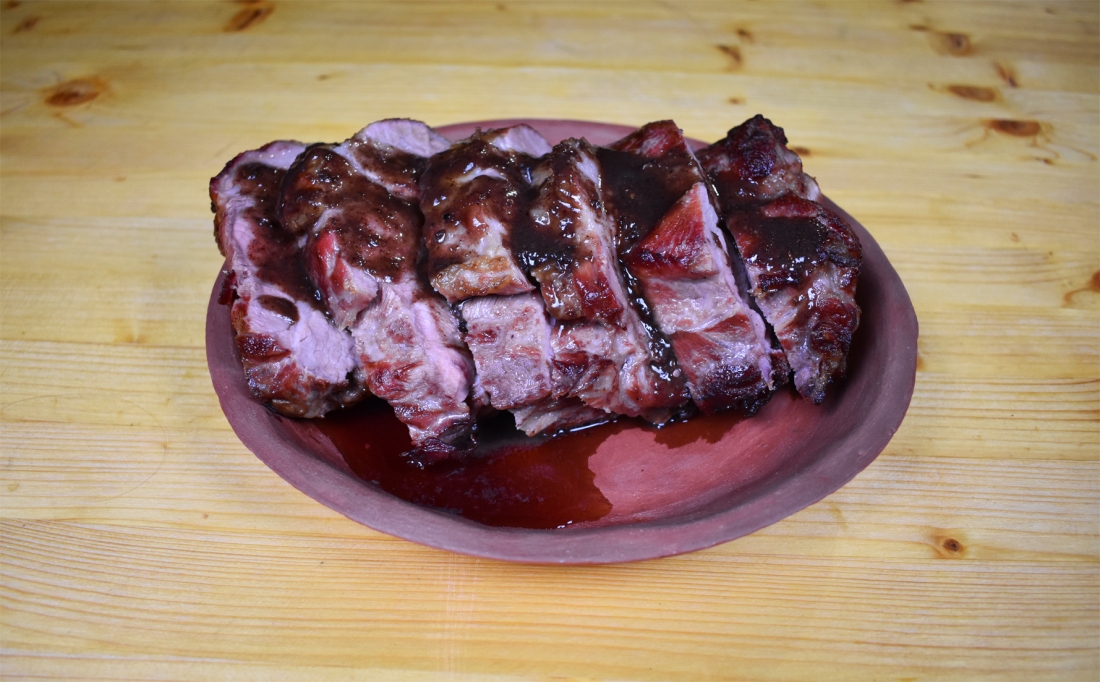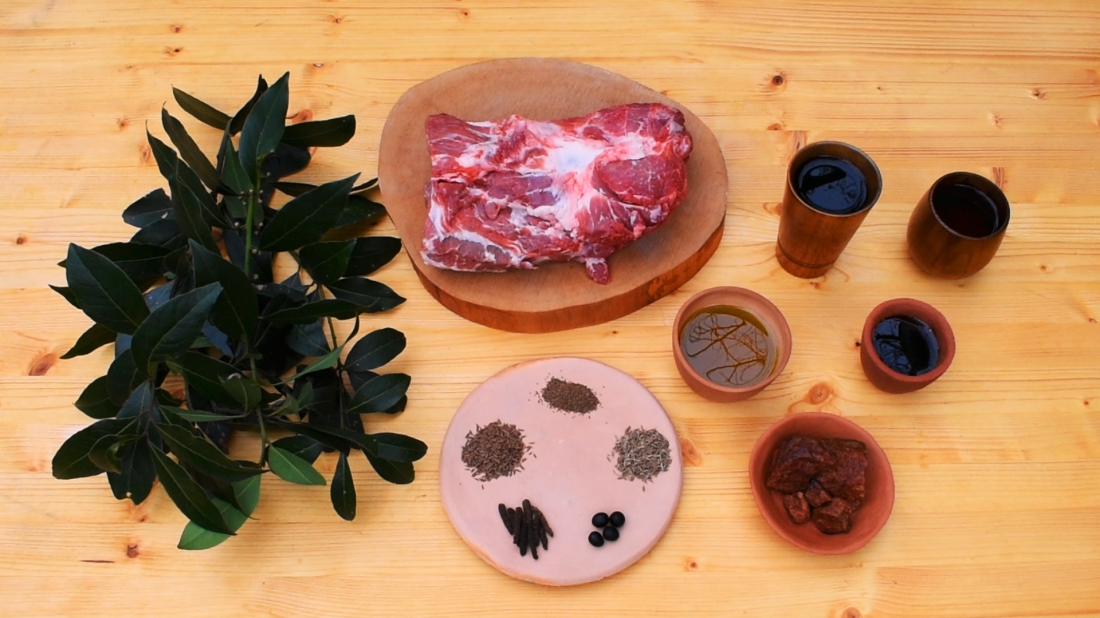For ancient Romans, December was a period of celebrations. One of the most important feasts of the year, indeed, was Saturnalia, originally the 17th of December; but, according to Macrobius and other authors, after the reform of the calendar made by Julius Caesar, Saturnalia were lengthened until the 23rd of December. The main characteristics of this festival were rich banquets and exchanges of gifts.
Typical gifts for Saturnalia, called by Catullus optimo dierum (the best of the days) were, among the others, lucanica sausages and fava beans, according to Martial.
The recipe we chose to celebrate Saturnalia is part of the book attributed to Marcus Gavius Apicius, the most famous ancient Roman cook. It is a recipe clearly meant for winter (typical spring aromatic herbs are absent), with a curious name, porcellum laureatum. Laureatum means seasoned with bay laurel, but it is possible ancient Romans interpreted this as a joke. Laureatum, indeed, was the emperor, crowned with a bay laurel wreath, as well as ancient Greek god Apollo. Bay laurel meant poetry, prophecy, but also military victory in the ancient world. In the 17th century, Italian writer Giulio Cesare Croce wrote a short humorous essay titled The Excellence and Triumph of the Pig, in which the author repeats a couple of time that the bay laurel is convenient to the pig because it is like a poet, and a crown made with bay laurel is a way to celebrate it.
To prepare a great Saturnalia feast, we suggest as starters epityrum, poached eggs, lettuce salad, and mustacei bread; as main courses this beautiful roast pork, fava beans, lucanica with mustard, and barley polenta. You can end your banquet with stuffed dates and fresh and dry fruit (pomegranates, raisins, dry figs, apples, preserved grapes). Next week we will prepare the most famous ancient sweet cake, the placenta, perfect as a dessert for Saturnalia.
Below, you will find a note about the ingredients, the original text with our translation, and the link to the video of the recipe, with English and Italian captions. Enjoy!
Ingredients
1,5 kg pork collar
red wine
raisin wine
extra virgin olive oil
garum
spices (asafoetida, long pepper, caraway, celery seeds, lovage)
many bay laurel leaves
1 or 2 bay laurel berries
Method
Parboil the meat in water for 15-20 minutes. In the meantime, pound in the mortar the bay laurel berries and the spices, grating a little asafoetida. Dilute with raisin and red wine, adding the oil and a little quantity of garum.
Drain the pork collar, keeping the broth aside.
Place the meat in the cooking vessel on the bay laurel leaves, covering it with the remaining leaves. Cook in the oven for at least one hour.
Meanwhile, cook the sauce for a few minutes until it is thickened.
When the roast is ready, remove the bay laurel leaves and plate, pouring a little broth and coating with the sauce.
Note about the ingredients
This recipe is meant for the whole roast pork, but you can choose the cut you prefer. We suggest using one with a good amount of fat for a better outcome. Apicius suggests stuffing the pork with bay laurel leaves. Using just a part, we covered it with the leaves instead.
We used at the end the cooking broth, but in the original recipe, the broth is prepared with the bones after deboning the pork.
Apicius uses here a great quantity of Mediterranean spices. If you do not have all of them, do not worry: remember that the main aroma must be the bay laurel. We chose to use long pepper, but the author does not specify what kind of pepper we have to use for this recipe. Long pepper is perfect with this flavorful roast, but ancient Romans had at disposal also the white and black varieties, as Pliny writes.
Asafoetida was one of the two varieties of silphium ancient Mediterranean populations used, called laser Parthicum. Though the most priced kind, called laser Cyrenaicum, seems to have been disappeared after the first centuries of the Common Era, according to Pliny, asafoetida is still used in many eastern countries. The author suggests using root of laser. We substitute it with the resin.
Garum was an ancient fish sauce, prepared with fermented fish and salt, sometimes adding spices and aromatic herbs. The simplest method to prepare it, according to the ancient sources survived, was identical to the way still today South-East Asian populations prepare their traditional fish sauces. As a consequence, fish sauce is the best modern substitute for garum. Otherwise, you can just use a pinch of salt instead.
Original text
Porcellum laureatum: porcellum exossas, quasi oenogaratum ornas, praeduras. Laurum viridem in medio franges satis, in furno assas, et mittes in mortarium piper, ligusticum, careum, apii semen, laseris radicem, bacas lauri. Fricabis, suffundes liquamen, et vino et passo temperabis. Adicies in caccabo cum olei modico, ut ferveat. Obligas. Porcellum lauro eximes et iure ab ossibus tanges et inferes.
Translation
Laureate pork: debone the pork, arrange the meat in the same way as you prepare oenogaratum [unluckily, there is not this recipe in the cookbook, but from the name, we know it is a preparation with wine and garum], parboil. Break enough fresh bay laurel leaves inside the pork, roast it in the oven, and put in the mortar lovage, caraway, celery seeds, root of laser, bay laurel berries. Pound them and pour garum, diluting with wine and raisin wine. Add in a pot with a little oil to boil. Let it thicken.
Remove the leaves from the pork, pouring a broth made with bones, and serve.
Ancient Roman Recipes Playlist
Recipes
Ancient Roman Poppy Seed Bread VIDEO
Ancient Roman Chestnuts VIDEO
Ancient Roman Cured Olives and Epityrum VIDEO
Ancient Roman Cheesecake (Libum) VIDEO
Ancient Roman Sweet Spelt VIDEO
Ancient Roman Pork Stew VIDEO
Ancient Roman Lettuce Salad with Oxyporum VIDEO
Ancient Roman Meatballs VIDEO
Ancient Roman Bonito VIDEO
Ancient Roman Cuttlefish Cakes VIDEO
Ancient Roman Sausage VIDEO
Ancient Roman Chicken VIDEO
Ancient Roman Barley Polenta VIDEO
Ancient Roman Farmer’s Meal – Flatbread and Moretum VIDEO
Ancient Roman Poached Eggs VIDEO
Ancient Roman Stew VIDEO
Ancient Roman Sea Bass VIDEO
Ancient Roman Stuffed Dates VIDEO
Ancient Roman Mussels VIDEO
Ancient Roman Taro VIDEO
Ancient Roman Guinea Fowl VIDEO
Ancient Roman Fava Beans VIDEO


